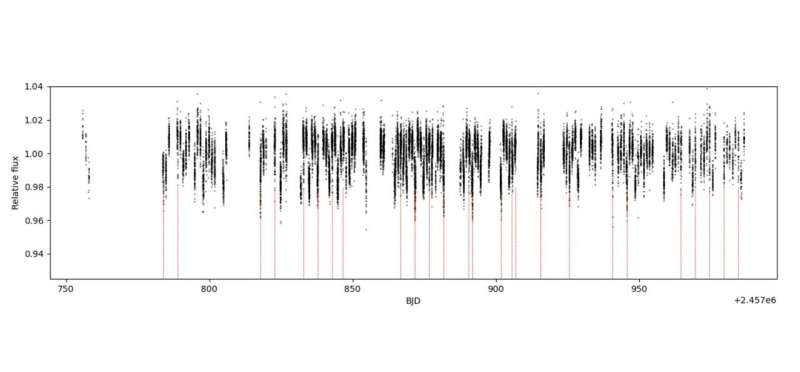February 23, 2024 report
This article has been reviewed according to Science X's editorial process and policies. Editors have highlighted the following attributes while ensuring the content's credibility:
fact-checked
preprint
trusted source
proofread
Astronomers detect a new short-period brown dwarf

While analyzing the data from the Next Generation Transit Survey (NGTS), an international team of astronomers has discovered a new brown dwarf. The newfound object, designated NGTS-28Ab, orbits its host star in just about 30 hours. The finding was reported in a paper posted February 15 on the preprint server arXiv.
Brown dwarfs (BDs) are intermediate objects between planets and stars, occupying the mass range between 13 and 80 Jupiter masses (0.012 and 0.076 solar masses). Although many brown dwarfs have been detected to date, these objects orbiting other stars are a rare find.
Now, a team of astronomers led by Beth A. Henderson of the University of Leicester, U.K., reports the discovery of such a rare new BD. Using the data from NGTS and also from NASA's Transiting Exoplanet Survey Satellite (TESS), they investigated the binary system known as NGTS-28.
"We first identified the brown dwarf within the Next Generation Transit Survey data, with supporting observations found in TESS sectors 11 and 38," the researchers wrote in the paper.
The team identified a massive object orbiting the primary star in the system—an M dwarf known as NGTS-28A. The brown dwarf nature of this object was confirmed by follow-up observations using several ground-based facilities, including the South African Astronomical Observatory (SAAO).
The newly detected brown dwarf is slightly smaller than Jupiter (0.95 Jupiter radii), but 69 times more massive than the solar system's biggest planet. This yields a density at a level of approximately 98.7 g/cm3.
According to the paper, NGTS-28Ab orbits its parent star every 30.1 hours, at a distance of some 0.02 AU. The brown dwarf has an equilibrium temperature of about 863 K and is estimated to be at least 500 million years old.
When it comes to NGTS-28A, it is about half the size and mass of the sun. It has an effective temperature of 3,626 K and is approximately 7 billion years old. The companion NGTS-28B has a similar effective temperature, but is about one-third smaller and less massive than the primary star. The system is located some 404 light years away.
The results make NGTS-28Ab one of the shortest period transiting BD within the "brown dwarf desert"—the lack of these objects orbiting main-sequence stars very closely (within 3 AU). NGTS-28Ab turns out to be orbiting one of the hottest M dwarfs within this desert.
"NGTS-28Ab provides a new opportunity to gain a deeper understanding of this region. The brown dwarf desert is believed to be caused by the minimal overlap of the tail of distributions between planetary and stellar formation mechanisms. Therefore, it is important to model parameters that can indicate the formation of each object," the authors of the study concluded.
More information: Beth A. Henderson et al, NGTS-28Ab: A short period transiting brown dwarf, arXiv (2024). DOI: 10.48550/arxiv.2402.09943
Journal information: arXiv
© 2024 Science X Network





















